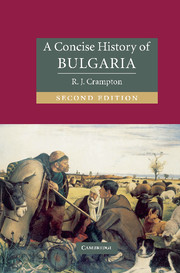Book contents
- Frontmatter
- Contents
- List of illustrations
- Preface
- Preface to the second edition
- Note on transliteration
- The Bulgarian lands: main rivers and mountains
- 1 THE BULGARIAN LANDS FROM PREHISTORY TO THE ARRIVAL OF THE BULGARIANS
- 2 MEDIAEVAL BULGARIA, 681–1393
- 3 OTTOMAN RULE IN THE BULGARIAN LANDS
- 4 THE NATIONAL REVIVAL AND THE LIBERATION
- 5 THE CONSOLIDATION OF THE BULGARIAN STATE, 1878–1896
- 6 FERDINAND'S PERSONAL RULE, 1896–1918
- 7 BULGARIA, 1918–1944
- 8 BULGARIA UNDER COMMUNIST RULE, 1944–1989
- 9 POST-COMMUNIST BULGARIA
- CONCLUSION
- Appendix 1 Bulgarian monarchs
- Appendix 2 Prime ministers of Bulgaria, 1879–2004
- Suggestions for further reading
- Index
- CAMBRIDGE CONCISE HISTORIES
CONCLUSION
Published online by Cambridge University Press: 05 June 2012
- Frontmatter
- Contents
- List of illustrations
- Preface
- Preface to the second edition
- Note on transliteration
- The Bulgarian lands: main rivers and mountains
- 1 THE BULGARIAN LANDS FROM PREHISTORY TO THE ARRIVAL OF THE BULGARIANS
- 2 MEDIAEVAL BULGARIA, 681–1393
- 3 OTTOMAN RULE IN THE BULGARIAN LANDS
- 4 THE NATIONAL REVIVAL AND THE LIBERATION
- 5 THE CONSOLIDATION OF THE BULGARIAN STATE, 1878–1896
- 6 FERDINAND'S PERSONAL RULE, 1896–1918
- 7 BULGARIA, 1918–1944
- 8 BULGARIA UNDER COMMUNIST RULE, 1944–1989
- 9 POST-COMMUNIST BULGARIA
- CONCLUSION
- Appendix 1 Bulgarian monarchs
- Appendix 2 Prime ministers of Bulgaria, 1879–2004
- Suggestions for further reading
- Index
- CAMBRIDGE CONCISE HISTORIES
Summary
At the time of writing, almost a decade and a half has passed since the fall of communism in Eastern Europe. The ‘post-totalitarian’ era has seen its own brand of cynicism and disillusion as the hopes for rapid material advance were disappointed and economic reform exacted a heavy social price. But in Bulgaria there is an extra dimension to the puzzlement and disillusion of post-totalitarianism.
It is significant that for more than half a decade after 1989 the Bulgarians were not able to agree upon a new state emblem. There was, it seemed, a sense of doubt as to their national identity and their place in the contemporary world. There have been many articles and books dealing with this issue. An excellent example is Ivan Elenkov and Rumen Daskalov's compilation, Zashto nie sme takiva; v tûrsene na bûlgarskata kulturna identichnost, published in Sofia in 1994. The title means ‘Why are we like we are? In search of Bulgaria's cultural identity’, and the book is a collection of fifty articles written by nineteen authors and published in Bulgarian journals between 1898 and 1943. All the articles try and define what it means to be Bulgarian, what is specific about ‘Bulgarianness’. At a time when the future contains many challenges as well as many possible rewards it is to the past that many present-day Bulgarians look for clues as to their true identity, for grid references to plot their position in an increasingly unstable and unsure world.
- Type
- Chapter
- Information
- A Concise History of Bulgaria , pp. 259 - 269Publisher: Cambridge University PressPrint publication year: 2005

